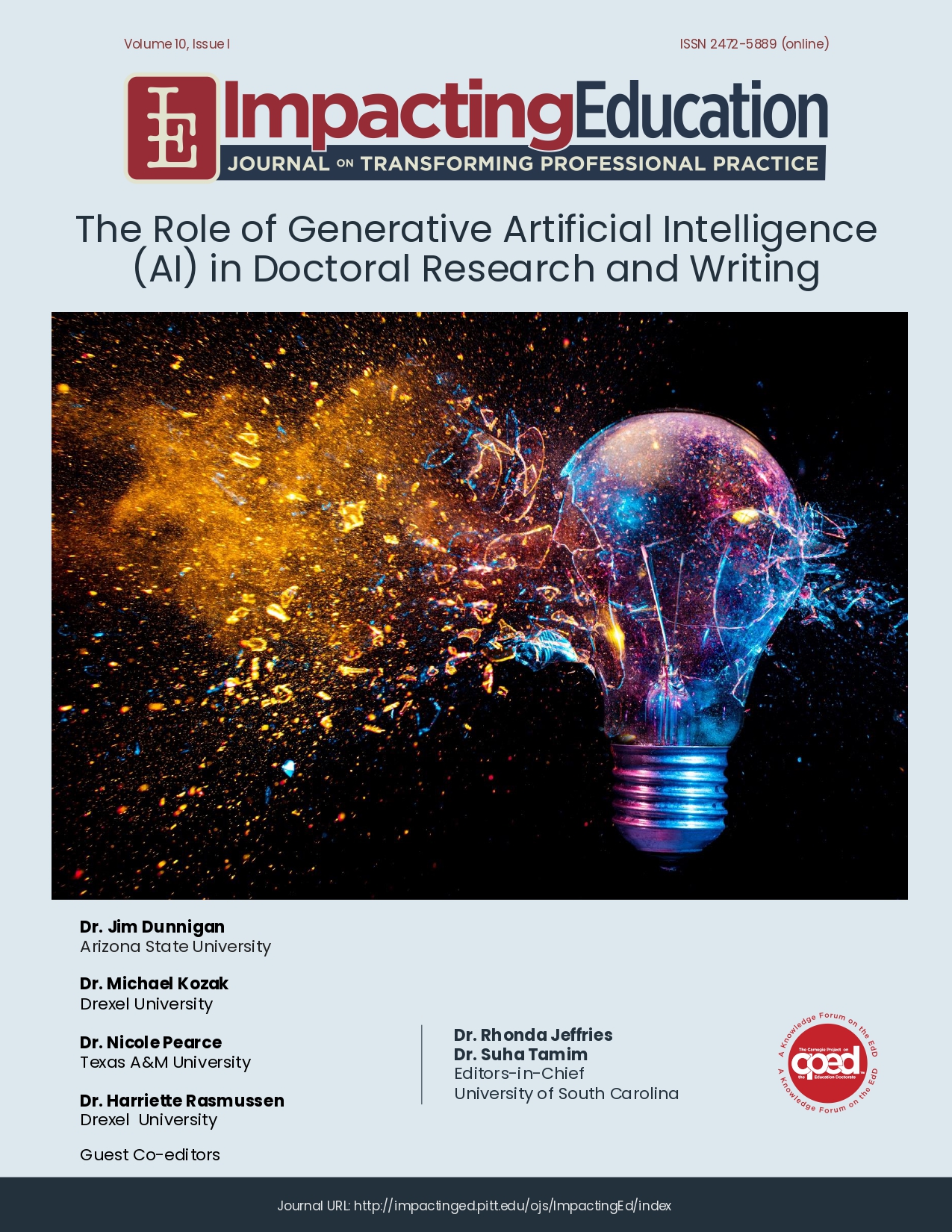Generative AI Use in an EdD Program
Informal, Independent Student Use and Formalized, Instructor-Directed Use
DOI:
https://doi.org/10.5195/ie.2025.476Keywords:
generative AI, research and writing, EdD programs, EdD students, generative AI and writing and researchAbstract
Generative AI has emerged as a tool to assist doctoral students as they conduct academic research and writing. In this study, we explored two ways AI has been used by students in our EdD program—informally and independently and in a more formalized, guided manner. First, we found students have been engaged in self-directed, informal, independent use of AI tools like Grammarly and Wordtune to aid them with writing. Other students used AI to summarize information from research studies and locate research articles. To be competitive, they believed that they needed to learn more about AI and its use. Second, we obtained data for students’ use of AI as they searched for theories to inform their research efforts. They were more confident to try out and utilize AI when instructors introduced it. Results indicated students found this use to be extremely helpful and a necessary tool for students in EdD programs.
References
Braun, V., & Clarke, V. (2006). Using thematic analysis in psychology. Qualitative Research in Psychology, 3(2), 77–101. https://doi.org/10.1191/1478088706qp063oa
Davis, F. D., Bagozzi, R. P., & Warshaw, P. R. (1989). User acceptance of computer technology: A comparison of two theoretical models. Management Science, 35(8), 982–1003. https://www.jstor.org/stable/2632151
Greene, J. C. (2007). Mixed methods in social inquiry. Jossey-Bass.
Lincoln, Y. S., & Guba, E. G. (1985). Naturalistic inquiry. Sage.
Richards, K. A. R., & Hemphill, M. A. (2018). A practical guide to collaborative qualitative data analysis. Journal of Teaching in Physical Education, 37(2), 225–231. https://doi.org/10.1123/jtpe.2017-0084
Teo, T. (2011). Factors influencing teachers’ intention to use technology: Model development and test. Computers & Education, 57(4), 2432–2440. https://doi.org/10.1016/j.compedu.2011.06.008
Teo, T. (2009). Modelling technology acceptance in education: A study of preservice teachers. Computers & Education, 52(2), 302–312. https://doi.org/10.1016/j.compedu.2008.08.006
Teo, T., Lee, C. B., Chai, C. S., & Wong, S. L. (2009). Assessing the intention to use technology among pre-service teachers in Singapore and Malaysia: A multi-group invariance analysis of the technology acceptance model (TAM). Computers & Education, 53(3), 1000–1009. https://doi.org/10.1016/j.compedu.2009.05.017
Downloads
Published
How to Cite
Issue
Section
License
Copyright (c) 2025 Ray Buss, Amy Markos, Josephine Marsh

This work is licensed under a Creative Commons Attribution 4.0 International License.
Authors who publish with this journal agree to the following terms:
- The Author retains copyright in the Work, where the term “Work” shall include all digital objects that may result in subsequent electronic publication or distribution.
- Upon acceptance of the Work, the author shall grant to the Publisher the right of first publication of the Work.
- The Author shall grant to the Publisher and its agents the nonexclusive perpetual right and license to publish, archive, and make accessible the Work in whole or in part in all forms of media now or hereafter known under a Creative Commons Attribution 4.0 International License or its equivalent, which, for the avoidance of doubt, allows others to copy, distribute, and transmit the Work under the following conditions:
- Attribution—other users must attribute the Work in the manner specified by the author as indicated on the journal Web site;
- The Author is able to enter into separate, additional contractual arrangements for the nonexclusive distribution of the journal's published version of the Work (e.g., post it to an institutional repository or publish it in a book), as long as there is provided in the document an acknowledgement of its initial publication in this journal.
- Authors are permitted and encouraged to post online a prepublication manuscript (but not the Publisher’s final formatted PDF version of the Work) in institutional repositories or on their Websites prior to and during the submission process, as it can lead to productive exchanges, as well as earlier and greater citation of published work. Any such posting made before acceptance and publication of the Work shall be updated upon publication to include a reference to the Publisher-assigned DOI (Digital Object Identifier) and a link to the online abstract for the final published Work in the Journal.
- Upon Publisher’s request, the Author agrees to furnish promptly to Publisher, at the Author’s own expense, written evidence of the permissions, licenses, and consents for use of third-party material included within the Work, except as determined by Publisher to be covered by the principles of Fair Use.
- The Author represents and warrants that:
- the Work is the Author’s original work;
- the Author has not transferred, and will not transfer, exclusive rights in the Work to any third party;
- the Work is not pending review or under consideration by another publisher;
- the Work has not previously been published;
- the Work contains no misrepresentation or infringement of the Work or property of other authors or third parties; and
- the Work contains no libel, invasion of privacy, or other unlawful matter.
- The Author agrees to indemnify and hold Publisher harmless from Author’s breach of the representations and warranties contained in Paragraph 6 above, as well as any claim or proceeding relating to Publisher’s use and publication of any content contained in the Work, including third-party content.
Revised 7/16/2018. Revision Description: Removed outdated link.



